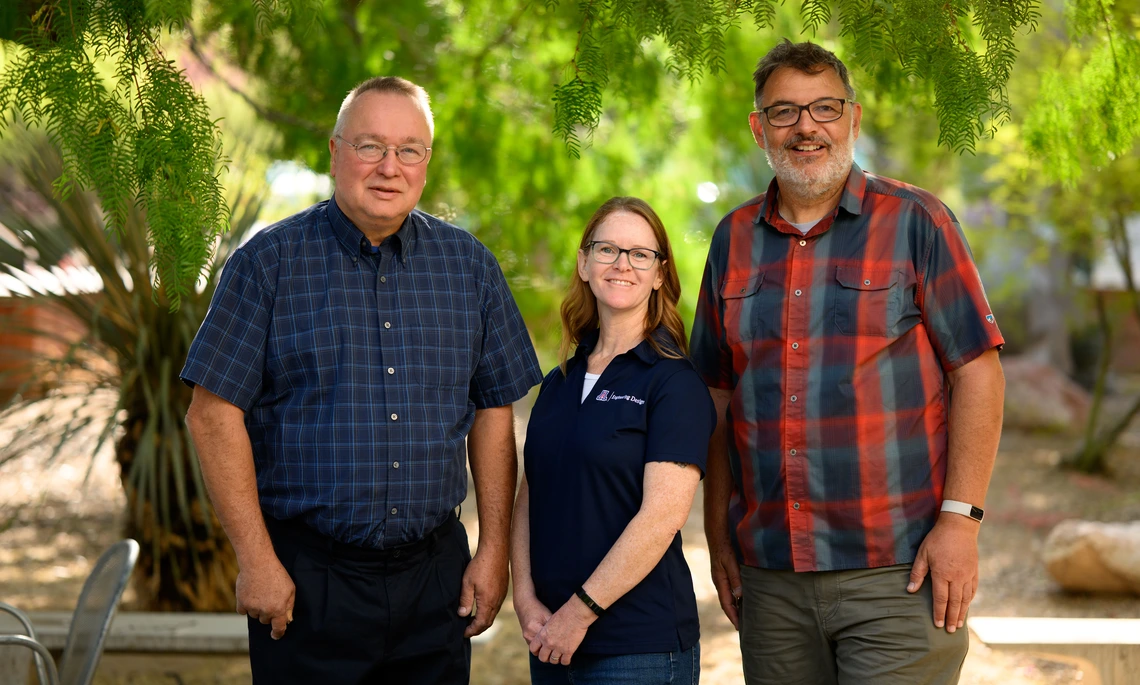Q&A with three ‘behind-the-curtain’ capstone champions

College of Engineering employees (from left) Joe Hartley, Nikki Heath and Urs Utzinger aid students when and how they most need help.
The Interdisciplinary Capstone program thrives thanks to the support and expertise of many. Sponsors, mentors, review panelists and judges play vital roles in ensuring College of Engineering students graduate with the experience of completing complex projects. However, behind-the-scenes staff and faculty also contribute significantly to student success. Meet three capstone champions who guide teams, build parts, and sometimes even procure rodents.
Joe Hartley is instrument shop supervisor, working out of the machine shop in the Aerospace and Mechanical Engineering Building. He and his colleagues contribute to capstone projects by advising students who are designing a variety of parts, fabricating those parts, and helping them with assembly – or redesign when needed. Hartley has been in the role for 17 years.
Nikki Heath is a relative newcomer to her position as a business administrator, having moved to the Engineering Business Center from AME in summer 2024. Heath works in the epicenter of capstone excitement – the Engineering Design Center. She and her teammates manage materials procurement: placing orders, resolving order-related issues, coordinating package deliveries and returns, advising students on best purchasing practices, and processing reimbursements.
Urs Utzinger is an associate professor or biomedical engineering who holds several joint appointments, including an associate professorship in optical sciences. Over the past 15 years, he has mentored around six capstone teams but assisted many more in an unofficial capacity. Utzinger teaches in the Salter Medical Device Design Lab and spends extra time there advising teams on design fabrication, as well as in the EDC. His input was key in setting up both facilities to give students the resources to execute their projects.
What is your approach to helping students?
Heath: Our goal is to make sure students receive the correct materials as quickly as possible. The students often need materials such as Arduinos and Raspberry Pis, but we have also received requests to purchase e-coli cultures, a stuffed rat, a golf putter, and other fun and interesting items.
Utzinger: Sometimes it's enough to just be interested and show the excitement I have for all projects that cross my path.
What’s it like to attend Craig M. Berge Design Day and see the completed projects on display?
Hartley: It’s fun to see how everything turns out. If you think about it like a theatrical production, 90% of what we see is behind the curtain. This is the curtain going up.
What do you appreciate about the people of the Interdisciplinary Capstone program?
Hartley: The student teams surprise me every year. Usually one or two teams, given the same resources as others, go so much further. I attribute that to cleverness, teamwork and planning.
Heath: I enjoy seeing the creativity and problem solving in the students’ work, and I like to witness their collaboration as they work in their teams at the EDC.
Utzinger: We’re fortunate to have college leaders and donors who really support the program. I see commitment toward the intellectual design process, but also the practical aspects of building. The teams now have homes where they can meet and fabricate. Building the Student Design Innovation Center will make a large impact. We’re working toward it, and I’m confident it will happen.

